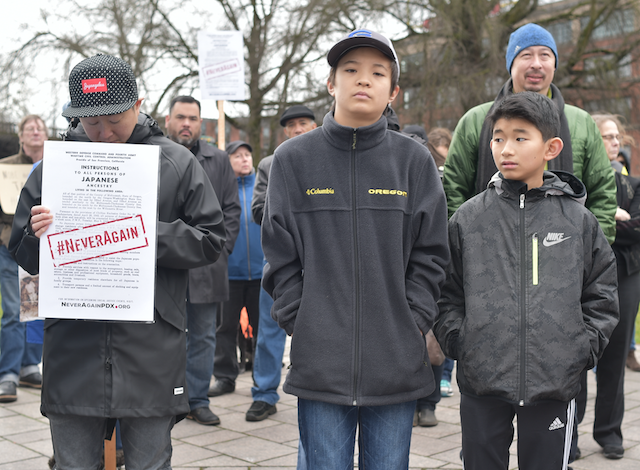
Story and photos by Pete Shaw
It’s been 75 years since President Franklin Delano Roosevelt signed Executive Order 9066, which resulted in the forced incarceration of over 120,000 people of Japanese ancestry.
The order, which in an immediate sense was a response to Japan’s attack on Pearl Harbor on December 7, 1941, resulted in a population of immigrants, about 60% of whom were US citizens, being stripped of nearly all their possessions and eventually forcibly removed to ten US Government camps located throughout the country on suspicion of being enemies of the United States.
To remember and bear witness to a past they refused to forget, a crowd of nearly 100 people gathered at the Japanese American Historical Plaza in Waterfront Park on Sunday February 19. Some told stories of their lives prior to, during, and after their incarceration. Others spoke of their relatives’ experience. Still more noted the ways they, a few generations removed, navigated the world. All demanded attention be paid.
“Thank you for coming out and participating in this radical act of remembering,” said A’misa Chiu to the crowd, at least two-thirds of which raised their hands when asked if they had been or knew a relative who had been forced by the government into an incarceration camp. “I think this year hits a little more hard, a little more personal, especially when we’re getting presidential executive orders now that ring too true to the pain and trauma of the Japanese American people.”
Executive Order 9066 was a heinous act on the part of Roosevelt and the US. Considering that people of German descent in the US were not rounded up in such numbers, nor subject to the same definition of their ethnicity (a person who was as little as 1/16 Japanese could be considered a security risk) it was clearly an act more born of racism than of protecting the country.
The gathering was not just recollection for the sake of not forgetting history. Less than a month has passed since Donald Trump issued an executive order banning immigrants from seven Muslim-majority countries from entering the US for 90 days, stopping all refugees from entering the country for 120 days, and indefinitely banning Syrian refugees. And as well, Trump has called for the Immigration and Customs Enforcement Agency (ICE) to be even more aggressive in its persecution of people without documentation than it was under President Obama.
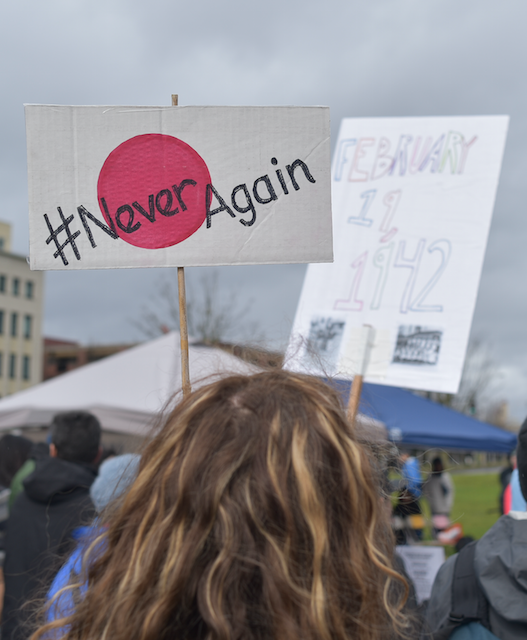 No, there was something more powerful going on here. History was being remembered in Waterfront Park as a reminder that people in the US have seen this type of systematic racism bearing the highest imprimatur of the land before, and that its injustice must be stopped.
No, there was something more powerful going on here. History was being remembered in Waterfront Park as a reminder that people in the US have seen this type of systematic racism bearing the highest imprimatur of the land before, and that its injustice must be stopped.
Chiu, who was born in Oakland and raised in Los Angeles, is a yonsei–a great-grandchild of Japanese immigrants. Her great-grandfather came to the US from Japan, eventually settling down as a celery farmer in Brooks, Oregon, just outside of Salem. When President Roosevelt issued Executive Order 9066, the family was forcibly removed to the Portland Assembly Center in North Portland (a converted livestock pavilion, now the Expo Center), and eventually to Tule Lake and Minidoka incarceration camps.
“I want you to remember,” said Chiu, “those who actually had this experience, who were stripped of their farms and homes, who were forcibly removed, who were taken–they had to leave behind their belongings and professions and language and family and friends and neighbors. We cannot forget that the pain of losing one’s home, belongings, language, and the trauma that comes from being locked up and forcibly imprisoned, the trauma of the crime of being Japanese, the trauma of the barbed wire and the wooden barracks, and the guard towers with machine guns facing inside for their protection.”
In particular, Chiu talked about the need to break “our generational silence” about incarceration camps and to risk being the loud person who makes people uncomfortable while speaking truth. She noted how when she was in high school in Gardena, California–which has the largest Japanese American population in the US outside of Honolulu, Hawai’i–her history textbook barely made mention of the incarceration camps. “Even growing up in a community like Gardena, California. Even growing up with a history of camp in my childhood at all times. I always knew about camp. I always knew about the incarceration. I always knew about World War II. But in our high school with 35% Asian Americans and a lot of them Japanese, we had two paragraphs about this. Two paragraphs. And the teacher looked around the classroom all full of Asian Americans, said the two paragraphs and moved on.”
“So it’s still happening today,” she continued. “The young kids are not getting their history in schools. This community has to be that schooling. This community has to teach the kids what happened because they’re not getting it in history books, still. It’s not happening. So I want to encourage all of you, if you don’t want to be that nail that is hammered down, we need to use our voices and our lives to speak out and advocate for others.”
Jenna Yokoyama, who along with Traci Kiyama organized the event, echoed Chiu’s thoughts on the importance of remembering. “People wanted to forget. The country wanted us to forget.” Yokoyama–a yonsei whose family was incarcerated in the camp in Manzanar–noted how the US government told the Japanese American people they were forcibly removing to incarceration camps that they were being patriotic Americans in going to those camps. “Can you imagine today,” she asked the audience, “watching your children going to jail and then telling yourself this is an American act?”
Sometimes it was twofold horror. Patricia Barnhart, whose grandmother was from near Osaka and who came to Riverside, California after an arranged marriage by two families in Japan, was holding a photo of her grandparents with three of their children, one of whom was her mother. After the executive order, Barnhart’s grandmother was forcibly removed to Gila River camp. Her grandfather was taken to another camp as men were deemed more of a threat to the US government and some, the government felt, had to be jailed separately. Two of their children went with Barnhart’s grandmother to Gila River. The other two, including Barnhart’s mother, were stuck in Japan, having been sent there, as per common practice at the time, to learn Japanese language and culture.
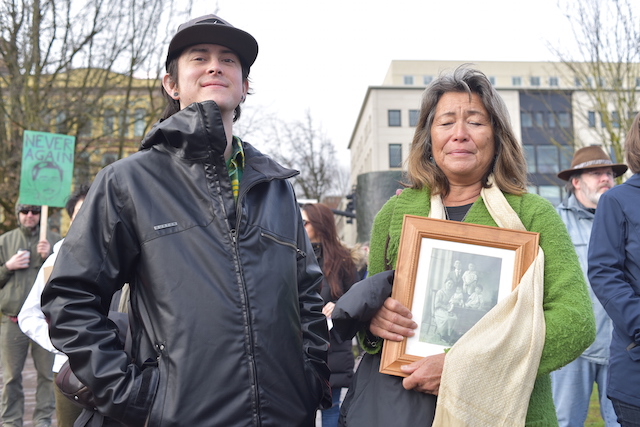 “I often think of my grandmother, how heartbreaking it must have been to have two children in Japan getting bombed by your country while you’re in camp with the rest of your family,” said Barnhart. “That would be very difficult.”
“I often think of my grandmother, how heartbreaking it must have been to have two children in Japan getting bombed by your country while you’re in camp with the rest of your family,” said Barnhart. “That would be very difficult.”
Kiyama, a yonsei, read some letters written by junior high school children in Seattle in March and April of 1942, just before they were forcibly removed to the incarceration camps. Their words sounded more or less like you would expect from children their age, except that the letters are written with the knowledge that they and their families and their friends soon will be taken away against their will. They express hopes of returning and seeing teachers, thanking them for what they have learned. The letters would be charming if the reason they were written was not so disturbing.
Kiyama said that her uncle was six years old when the US government sent him to an incarceration camp, only slightly older than her four year old son. “That’s who were sent. That’s who the government said were traitors.”
Canaan Schlesinger, a yonsei, began with a sobering quotation that showed Executive Order 9066 did not just appear out of the blue, but rather was the product of a history of racism. “Anyone who has traveled to the Far East knows that the mingling of Asiatic blood with European or American blood produces in 9 cases out of 10 the most unfortunate results. In this question then of Japanese exclusion from the United States, it is necessary only to advance the true reason: the undesirability of mixing the blood of the two peoples. There can be no quarrel there.”
Those words, from 1925, were written by Franklin Delano Roosevelt, 17 years prior to his Executive Order 9066. Likewise, Donald Trump’s Muslim ban did not sprout from nothing. The first Gulf War which saw a US led invasion of Iraq ushered in the recent rise of anti-Muslim hysteria, which was brought to a crescendo following the hijackings and jet-bombings on September 11, 2001. The amount of hatred being leveled against people who were Muslim–or fit the stereotype of a Muslim–was immense, and that hatred, as well as its resultant violence, continues and leads right to Trump’s Muslim ban. The people who are the object of the ban may look different than those whom Roosevelt authorized to be thrown into incarceration camps, but the racism at its heart is similar, as is the history leading up to the orders.
“It’s important to remember that all of this is not just about a moment,” said Yokoyama. “It’s not about when people get taken away to camp. It’s about everything that leads up to it, and that’s what we’re trying to take down here and to remember. It takes a lot of people, and it takes many, many years and a lot of people condoning those xenophobic attitudes that allows those things to happen.”
Schlesinger made a crucial point about the fallacy of saying Executive Order 9066 was a mistake, connecting it with the continuing crackdown on immigrants without documentation. “It wasn’t a mistake,” he said. “It wasn’t any more of a mistake than the executive orders that are being signed right now and that are probably going to continue to be signed. It’s not a mistake that people in this city within two miles of us are probably being detained.”
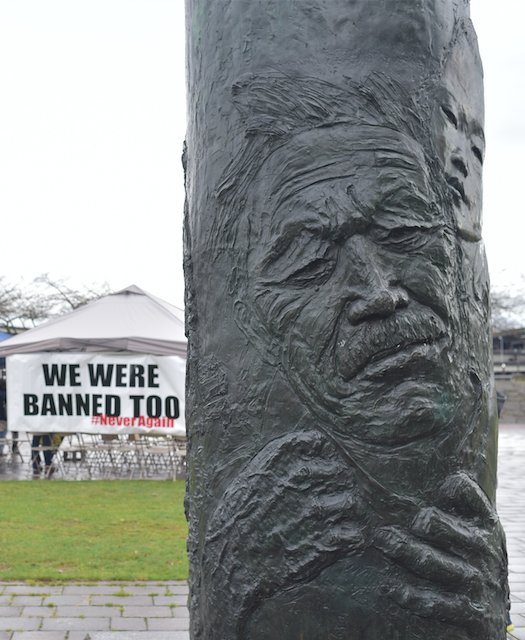 And the mechanism of that systemic racism is deeper than it appears. When a person without documentation is detained by ICE, she is taken through a long series of steps between her seizure and possible deportation that rarely, if ever, merit news coverage. Similarly, the forcible removal and incarceration of Japanese Americans was not a process of simply transporting these people to the camps. There was a vast bureaucracy dedicated to rounding up and moving the Japanese Americans. They had to be processed at one of eighteen Civilian Assembly Centers. They had to be sorted as to which camps they would be sent. And numerous people were held in other facilities such as the nine US Department of Justice prisons, three Citizen Isolation Centers, three FBI prisons, eighteen US Army facilities, and seven Immigration and Naturalization Services facilities.
And the mechanism of that systemic racism is deeper than it appears. When a person without documentation is detained by ICE, she is taken through a long series of steps between her seizure and possible deportation that rarely, if ever, merit news coverage. Similarly, the forcible removal and incarceration of Japanese Americans was not a process of simply transporting these people to the camps. There was a vast bureaucracy dedicated to rounding up and moving the Japanese Americans. They had to be processed at one of eighteen Civilian Assembly Centers. They had to be sorted as to which camps they would be sent. And numerous people were held in other facilities such as the nine US Department of Justice prisons, three Citizen Isolation Centers, three FBI prisons, eighteen US Army facilities, and seven Immigration and Naturalization Services facilities.
That was not a mistake. That is not a mistake.
The consequences of such willful non-mistakes hit home for Amanda Shanahan, a fourth generation Japanese American whose grandmother, Ruth, was forcibly taken to an incarceration camp. Shanahan sees clear similarities between the crackdown on Japanese Americans that swept up people like her grandmother and modern day sweeps of people lacking documentation. “To think that the same fear mongering, demonizing, racism, and xenophobia that allowed this to happen is still happening today is now impacting other marginalized communities to me is maddening and not acceptable.”
Shanahan works at a university alongside students without documentation and students whose parents and other family members lack documentation. “The fact that they now, instead of worrying about their next midterm, must worry about whether or not their parents are gonna be there when they get home, or whether or not their hopes and dreams are even worth holding on to. To me that is so sad and so frustrating. And this is the reason why I think it is so important for us to remember.”
Kiyama and Yokoyama had originally assumed there would be an event marking the 75th anniversary of the signing of Executive Order 9066, and it was only a few weeks ago that they found out the commemoration planned by the Oregon Nikkei Endowment and the Portland Japanese American Citizens League (JACL) would be held on May 6, the date that Japanese Americans were forcibly removed from the City of Portland and herded to the Assembly Center.
Jeff Selby, a second generation Japanese American (but not Nisei) who was representing the Nikkei Community as a former president of the Portland JACL, praised Kiyama and Yokohama for putting together Sunday’s event. “Thank goodness for Jenna and Traci,” he told the crowd, “who were saying, ‘There’s got to be some sort of event for day of remembrance this year.’ And they couldn’t find one, so they said, ‘We’ll just do it ourselves.’ I think it’s an amazing thing.”
Selby said a month after he moved to Portland on September 11, 2001, the Portland JACL and the Nikkei Community held a Dialogue for Peace, “reaching out to the Arab and Muslim community to say, ‘Our community understands what is happening with xenophobia and fear and hate and white supremacy. We understand this.’”
Selby also noted that when he returned to Indiana a few years ago, the same people who had been doing the work of the “Hoosier chapter” of the JACL–which Selby’s parents had started when he was a child–were still running it. But far fewer younger people were involved. He has seen a similar dynamic in Portland. “It’s the same folks who are doing it.”
“We need people to be more active,” Selby said. Especially now. And I’m asking you all to be involved more.”
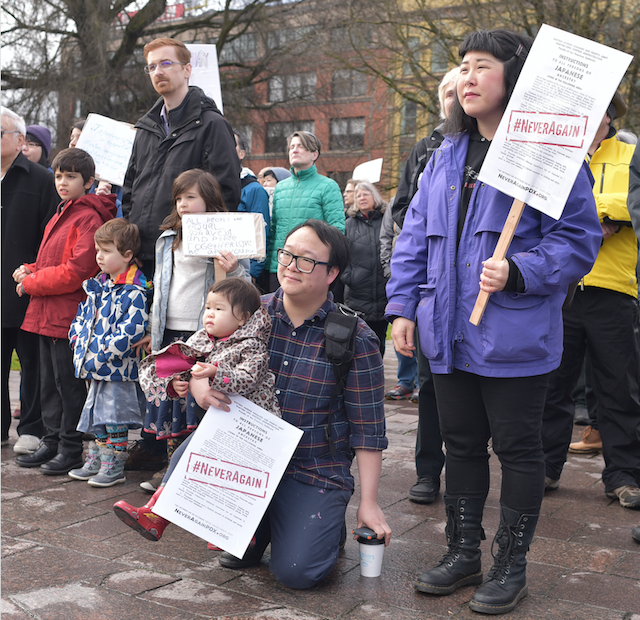 “This event is sort of an attempt to bring a community together, to start doing that work together,” Yokoyama later said. “We have organizations like the Japanese American Citizens League here in this city, we also have the Oregon Nikkei Legacy Center–so we have these kind of older institutions here that people are members of within the Japanese American community, but I want to say that the membership doesn’t have as many young members as they would like, and so this was an attempt to reach out to members of the Japanese American community that hasn’t really felt like they’re part of a larger community and so we’re actually hoping that through this event today that we’ll be able to bring people together to start doing actions beyond just remembering this day and hopefully it will create some sort of momentum to cause younger people to feel like it’s time for them to speak out.”
“This event is sort of an attempt to bring a community together, to start doing that work together,” Yokoyama later said. “We have organizations like the Japanese American Citizens League here in this city, we also have the Oregon Nikkei Legacy Center–so we have these kind of older institutions here that people are members of within the Japanese American community, but I want to say that the membership doesn’t have as many young members as they would like, and so this was an attempt to reach out to members of the Japanese American community that hasn’t really felt like they’re part of a larger community and so we’re actually hoping that through this event today that we’ll be able to bring people together to start doing actions beyond just remembering this day and hopefully it will create some sort of momentum to cause younger people to feel like it’s time for them to speak out.”
Speaking out is no easy task. Not when a trauma of this magnitude gets passed through the generations. The younger people who spoke at the rally were courageously wrestling with a past that often told them to be quiet and with a future that is already seeing people without documentation being torn away from their families and communities, and may include bans on Muslims as well as other groups deemed unfit for the US.
“I inherited a knowledge of pain and trauma from the camps,” said Chiu. “Four generations worth. And I speak for my family who could not. I’m angry at an America that chose to lock up and incarcerate US citizens based on race and ethnicity. I’m angry now at the head Republican president who uses executive power to issue an immigration ban to seven Muslim nations. Both executive orders are made from fear, ignorance, bigotry, and uphold systematic racism and white supremacy. And during World War II times, we needed people to speak up for the Japanese Americans in community and solidarity, together. And in this time, we need to speak up for Muslim lives. We need to speak up for Black lives. We need to speak up for immigrant and refugee lives. We need to speak up for native lives. We need to speak up for queer and trans lives. And we need to do it as Japanese Americans that know and understand this history because we were too banned.”
Want to get involved? Visit www.neveragainpdx.org for more information about events going on in Portland’s Japanese American community.
Japanese Americans (with and without the hyphen) who are not involved in established organizations, but wish to get involved in activism and organizing should check out the Facebook group PDX Japanese-Americans.






